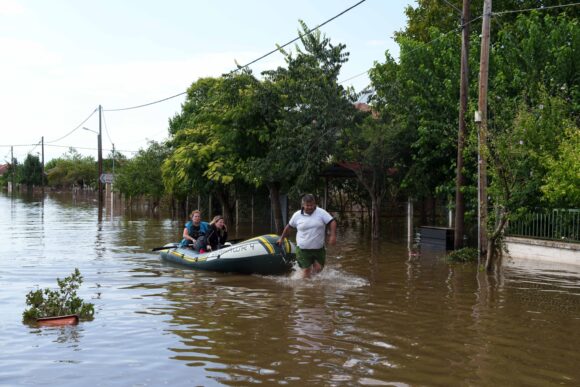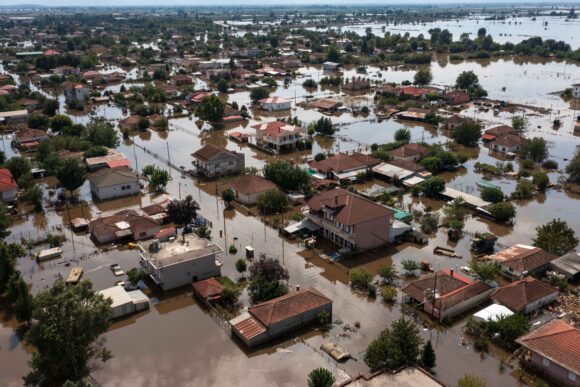The low-pressure weather system that unleashed unprecedented amounts of rain across the eastern Mediterranean last week was made more likely and more intense by climate change.
Global warming caused by human emissions of greenhouse gases made the heavy rainfall over Greece, Bulgaria and Turkey up to 10 times more likely, and the deluge in Libya up to 50 times more likely. That’s according to World Weather Attribution, a group of climate scientists that rapidly analyzes weather data after natural disasters to determine the influence of climate change.
“It is a worldwide phenomenon and we can see it everywhere in the world — when it rains, it rains a lot,” said Kostas Lagouvardos, research director at the National Observatory of Athens in Greece and a co-author of the study. “That’s a problem because many dams and infrastructure to fight floods were built with data that’s started to not be valid anymore.”
The Mediterranean basin is warming 20% faster than the rest of the planet, according to the United Nations. While the region is becoming drier overall, climate change is making weather harder to predict and contributing to violent storms that release large amounts of rain in very short periods of time. That, coupled with a lack of preparedness on the ground, lead to close to 4,000 deaths in Libya.

Storm Danielwas the worst storm to hit Greece since records began in 1930. It was also the deadliest since 2008, when more than 130,000 people died as Cyclone Nargis landed on Myanmar.
The storm hit Greece from Sept. 4 to 7 and released 760 millimeters of water per square meter in a day in some places. Heavy rains flooded the Thessaly plain, home to a quarter of the country’s agriculture production. The WWA analysis showed carbon emissions are linked to up to 40% more rain than would have fallen if the planet hadn’t heated up so much.
Such extreme cases of heavy rainfall are now reasonably common, the WWAscientists said, and can be expected once in every decade. That’s a 10% chance of happening every year in the large region that includes Greece, Bulgaria and Turkey. In central Greece, such an event is only expected to happen once every 80 to 100 years.
“This event was a breaking point for Greece,” Lagouvardos told reporters on Tuesday. “After storm Daniel we have to revisit again all our policies for early warning systems and the structure of our civil protection agencies so first respondents and scientists work together to be better prepared for disastrous events in coming years.”
After hitting Greece, the storm moved south over the Mediterranean sea and gained new strength before making landfall in Libya. Scientists are investigating whether it could be considered a medicane — a portmanteau of “Mediterranean” and “hurricane.” While it behaved like one, Lagouvardos said its slow movement and stagnation has led experts to suspect it wasn’t.
The WWA study found that the heavy rains that hit Libya in the early hours of Sept. 11 are expected to happen around once in 300 to 600 years in the current climate.Global warming increased their intensity by as much as 50%. More than 10,000 people are still missing in the city of Derna as rescue teams work against the clock to find survivors.
The high death toll can’t be attributed to the rains alone. Two dams and several bridges collapsed, flooding entire districts in Derna. A decade-long armed conflict, the political instability that ensued and weak institutions resulted in poor maintenance of key infrastructure — including the dams — and lack of planning and protocols to respond to extreme weather events.
“In Libya there was a forecast with a three-day lead time,” said Maja Vahlberg, a risk consultant with the Climate Centre, an organization helping the Red Cross Red Crescent Movement address the humanitarian impacts of global warming. “But the impact of that potential rainfall on people and infrastructure was not well understood, and it’s not clear how the forecast was communicated.”
The disaster points to the challenge of maintaining old infrastructure, and adapting it to the weather conditions of the present, she said. In the case of Libya, that means taking into account a long-term decline in rainfall while also preparing for more extreme rain at times.
That seeming contradiction should not complicate adaptation efforts, because many actions needed to address both drought and floods are the same, said Friederike Otto, a senior lecturer in climate science at the Grantham Institute for Climate Change in the UK and co-founder of WWA.
“Reforestation, re-naturalization of rivers, the de-sealing of grounds are very important measures to adapt to drought and floods,” she said. “Access to early warning systems, information and healthcare help throughout all changes and extremes, not just one type.”
Top photograph: Flooded homes and buildings following heavy rain in Palamas in Karditsa region, Greece, on Sept. 8, 2023. After suffering deadly wildfires over the summer, Greece was hit by Storm Daniel. Photo credit: Konstantinos Tsakalidis/Bloomberg
Topics Flood Climate Change
Was this article valuable?
Here are more articles you may enjoy.



 BlackSuit Cybercrime Gang Blamed in CDK Hack That Roiled Car Dealers
BlackSuit Cybercrime Gang Blamed in CDK Hack That Roiled Car Dealers  GEICO Tops Progressive With Higher J.D. Power Scores
GEICO Tops Progressive With Higher J.D. Power Scores  Supreme Court Overturns Chevron Rule in Blow to Regulators
Supreme Court Overturns Chevron Rule in Blow to Regulators  As Rates Rise, Majority of Homeowners Say Insurance Industry Is in Crisis: Survey
As Rates Rise, Majority of Homeowners Say Insurance Industry Is in Crisis: Survey 

